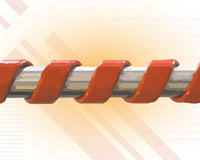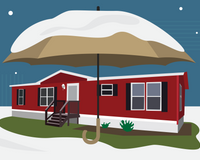Mobile home underpinning — also referred to as skirting — forms a protective barrier around the perimeter of your mobile home between the trailer floor and the ground. Many materials can serve this purpose, but vinyl underpinning for mobile homes is the most common by far. Vinyl (aka polyvinyl chloride or PVC) is well-regarded for its economy, its ease of installation, and relatively painless repair.
Mobile home underpinning is sold either by the panel (for spot repairs) or in skirting kits that include everything you need for a full replacement — panels, guide tracks/rails, and skirt guards. See our past blog on how to install mobile home skirting.
Why you need mobile home underpinning
There are several reasons why mobile home underpinning should be viewed as a necessity, not an option.
- Aesthetics — forgoing underpinning makes your home look unfinished
- Critter control — underpinning prevents creatures from taking residence in the crawlspace under your mobile home trailer.
- Protection — shields your home’s foundation, wiring, and plumbing from the elements.
- Insulation and ventilation
How to protect and preserve your mobile home underpinning
Properly maintaining your mobile home underpinning is a lot cheaper than replacing it. Vinyl underpinning for mobile homes has two big weaknesses:
Moisture buildup
Moisture buildup can be devastating over time, causing discoloration and rot. To ensure things stay nice and dry, keep the underpinning clear of leaves and debris, and make absolutely certain it’s properly ventilated and drained.
A general rule of thumb for proper skirting ventilation is one square foot of venting for every 150 square feet of floor space. For single-wide mobile homes, you’ll need approximately 5 to 10 feet venting; for double-wides, you’ll need about 10 to 19.
Weed eaters
Remember how we mentioned that you should keep the area around your mobile home underpinning trimmed and clean? Well there’s a bit of a dilemma attached to that — edging around your dwelling often requires the services of a weed eater. These landscaping tools are notorious for cracking, cutting, and altogether compromising vinyl skirting panels.
One way to avoid weed eater damage is to prevent weeds or grass from growing next to the underpinning to begin with. Some homeowners will employ commercial weed killers, while others will lay down gravel or another material that inhibits or forestalls growth. When these measures are not possible, skirt guards can be snapped onto the existing bottom track of your underpinning as a last line of defense.
When to repair underpinning vs. when to replace
Even with a cheaper material such as vinyl, completely replacing your mobile home underpinning can be a pricey endeavor — more so if you’re having it professionally installed. Replace damaged panels individually before committing to starting over.
Minor repairs
Dents and dings may be unsightly, but can generally be left alone. For smaller cracks and holes, seal with a good quality mortar, caulk, or epoxy filler — make sure they’re rated for all weather or exterior use. Applying weather resistant tape is another inexpensive method to patch breaches in your underpinning
Replacement skirting panels and skirting kits with Star Mobile!
Vinyl mobile home underpinning is a great choice for most mobile home owners (but if you’re curious, here are some other skirting ideas), but as with many things, time eventually takes its toll. Luckily, Star Mobile Home Supply has everything you need to restore this essential functional and aesthetic component of your mobile home.






